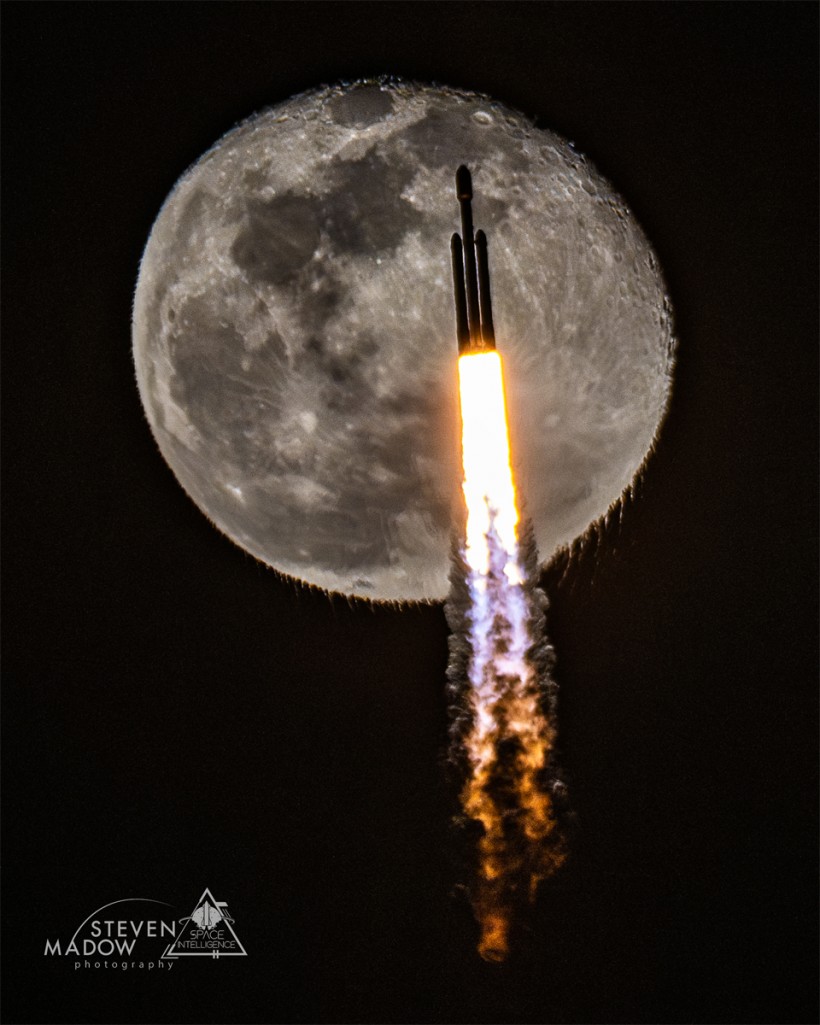NASA's Picture of the Day features a rippling wonder captured in space! The sci-fi-looking image depicts the SpaceX Falcon Heavy rocket surging toward the moonlit sky, creating enchanting ripples as it transits the lunar backdrop.
Astrophotographer Steven Madow skillfully captured this fantastic moment, showcasing the ethereal convergence of the rocket's exhaust plume and the serene night sky.

The SpaceX and the Moon
The SpaceX Falcon Heavy, renowned for its power and iconic status, embarked on a space journey from NASA's Kennedy Space Center, leaving a visually striking mark on the cosmic tableau.
Meticulously planned and impeccably timed, the photograph unveils a distinctive interplay of light and shadow. The rocket's plume extends beyond its silhouette, casting a mesmerizing trail onto the distant, rising, and almost fully illuminated moon.
The unexpected appearance of drip-like ripples along the moon's lower edge makes this image even more amazing. While it seems the rocket's passage caused lunar distortions, the moon itself, located far in the distance, remained unchanged.
NASA explained that the optical illusion of ripples resulted from the peculiar behavior of light known as refraction. In the realm of physics, refraction occurs when light travels through different mediums, such as pockets of air with varying temperatures or densities.
In this instance, the pockets of relatively hot or rarefied air interacted with moonlight differently than the cooler or compressed air pockets. The result was a visual distortion, creating the appearance of gentle waves along the moon's lower edge.
The planned nature of the shot emphasizes the precision required for astrophotography, as the timing had to be meticulously orchestrated to capture the fleeting moment when the rocket transited the moon during a single exposure.
Read Also: NASA's James Webb Space Telescope Captures Stunning Image of 'Hidden' Ghostlike Dusty Galaxy
Shakespeare in Space
In related news, NASA's Picture of the Day on December 29 highlights a fascinating blend of Shakespearean inspiration and celestial marvels, unveiling the ice giant Uranus as the focal point.
While Voyager 2 made history by conducting the first close-up exploration of Uranus in 1986, the James Webb Space Telescope, equipped with the Near-Infrared Camera (NIRCam), has now treated humanity to a detailed portrayal of this distant planetary giant.
The recently unveiled picture provides a mesmerizing glimpse of Uranus, an inclined outer planet gracefully rotating on its axis approximately every 17 hours.
With its north pole currently in view, the image offers a direct perspective of Uranus' northern hemisphere, adorned with a faint yet expansive system of rings. The image showcases their presence through the distinctive diffraction spikes of the Webb telescope, highlighting 14 out of the 27 known moons of Uranus.
Beyond capturing the beauty of Uranus and its lunar companions, the image also pays tribute to the enduring influence of William Shakespeare. Read the story here to learn more about this Shakespearean image.
Related Article: New Computer Simulation Sheds Light on Early Galaxy Formation Aligned With NASA James Webb's Observations










